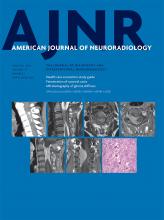Index by author
Tomassello, A.
- InterventionalOpen AccessPosttreatment Infarct Volumes when Compared with 24-Hour and 90-Day Clinical Outcomes: Insights from the REVASCAT Randomized Controlled TrialF.S. Al-Ajlan, A.S. Al Sultan, P. Minhas, Z. Assis, M.A. de Miquel, M. Millán, L. San Román, A. Tomassello, A.M. Demchuk, T.G. Jovin, P. Cuadras, A. Dávalos, M. Goyal and B.K. Menon for the REVASCAT InvestigatorsAmerican Journal of Neuroradiology January 2018, 39 (1) 107-110; DOI: https://doi.org/10.3174/ajnr.A5463
Tosetti, M.
- Adult BrainOpen AccessSemiautomated Evaluation of the Primary Motor Cortex in Patients with Amyotrophic Lateral Sclerosis at 3TG. Donatelli, A. Retico, E. Caldarazzo Ienco, P. Cecchi, M. Costagli, D. Frosini, L. Biagi, M. Tosetti, G. Siciliano and M. CosottiniAmerican Journal of Neuroradiology January 2018, 39 (1) 63-69; DOI: https://doi.org/10.3174/ajnr.A5423
Tu, R.
- Open AccessHealth Care Economics: A Study Guide for Neuroradiology Fellows, Part 1S.L. Weiner, R. Tu, R. Javan and M.R. TaheriAmerican Journal of Neuroradiology January 2018, 39 (1) 2-9; DOI: https://doi.org/10.3174/ajnr.A5381
- Open AccessHealth Care Economics: A Study Guide for Neuroradiology Fellows, Part 2S.L. Weiner, R. Tu, R. Javan and M.R. TaheriAmerican Journal of Neuroradiology January 2018, 39 (1) 10-17; DOI: https://doi.org/10.3174/ajnr.A5382
Turc, G.
- FELLOWS' JOURNAL CLUBAdult BrainYou have accessDo Fluid-Attenuated Inversion Recovery Vascular Hyperintensities Represent Good Collaterals before Reperfusion Therapy?E. Mahdjoub, G. Turc, L. Legrand, J. Benzakoun, M. Edjlali, P. Seners, S. Charron, W. Ben Hassen, O. Naggara, J.-F. Meder, J.-L. Mas, J.-C. Baron and C. OppenheimAmerican Journal of Neuroradiology January 2018, 39 (1) 77-83; DOI: https://doi.org/10.3174/ajnr.A5431
The authors evaluated 244 consecutive patients eligible for reperfusion therapy with MCA stroke and pretreatment MR imaging with both FLAIR and PWI. The FLAIR vascular hyperintensity score was based on ASPECTS, ranging from 0 (no FLAIR vascular hyperintensity) to 7 (FLAIR vascular hyperintensities abutting all ASPECTS cortical areas). The hypoperfusion intensity ratio was defined as the ratio of the time-to-maximum >10-second over time-to-maximum >6-second lesion volumes. The FLAIR vascular hyperintensities were more extensive in patients with good collaterals than those with poor collaterals. The FLAIR vascular hyperintensity score was independently associated with good collaterals. They conclude that the ASPECTS assessment of FLAIR vascular hyperintensities could be used to rapidly identify patients more likely to benefit from reperfusion therapy.
Uno, T.
- Peripheral Nervous SystemYou have accessMR Imaging of the Superior Cervical Ganglion and Inferior Ganglion of the Vagus Nerve: Structures That Can Mimic Pathologic Retropharyngeal Lymph NodesH. Yokota, H. Mukai, S. Hattori, K. Yamada, Y. Anzai and T. UnoAmerican Journal of Neuroradiology January 2018, 39 (1) 170-176; DOI: https://doi.org/10.3174/ajnr.A5434
Van Schijndel, R.A.
- EDITOR'S CHOICEAdult BrainOpen AccessReproducibility of Deep Gray Matter Atrophy Rate Measurement in a Large Multicenter DatasetA. Meijerman, H. Amiri, M.D. Steenwijk, M.A. Jonker, R.A. van Schijndel, K.S. Cover and H. Vrenken for the Alzheimer's Disease Neuroimaging InitiativeAmerican Journal of Neuroradiology January 2018, 39 (1) 46-53; DOI: https://doi.org/10.3174/ajnr.A5459
The authors assessedthereproducibilityof2automatedsegmentationsoftwarepackages(FreeSurferandthe FMRIB Integrated Registration and Segmentation Tool) by quantifying the volume changes of deep GM structures by using back-to-back MR imaging scans from the Alzheimer Disease Neuroimaging Initiative's multicenter dataset in 562 subjects. Back-to-back differences in 1-year percentage volume change were approximately 1.5–3.5 times larger than the mean measured 1-year volume change of those structures. They conclude that longitudinal deep GM atrophy measures should be interpreted with caution and that deep GM atrophy measurement techniques require substantially improved reproducibility, specifically when aiming for personalized medicine.
Verma, G.
- EDITOR'S CHOICEHead and Neck ImagingOpen AccessDynamic Contrast-Enhanced MRI–Derived Intracellular Water Lifetime (τi): A Prognostic Marker for Patients with Head and Neck Squamous Cell CarcinomasS. Chawla, L.A. Loevner, S.G. Kim, W.-T. Hwang, S. Wang, G. Verma, S. Mohan, V. LiVolsi, H. Quon and H. PoptaniAmerican Journal of Neuroradiology January 2018, 39 (1) 138-144; DOI: https://doi.org/10.3174/ajnr.A5440
The authors evaluated 60 patients with dynamic contrast-enhanced MR imaging before treatment. Median, mean intracellular water molecule lifetime, and volume transfer constant values from metastatic nodes were computed from each patient. Kaplan-Meier analyses were performed to associate mean intracellular water molecule lifetime and volume transfer constant and their combination with overall survival and beyond. Patients with high mean intracellular water molecule lifetime had overall survival significantly prolonged by 5 years compared with those with low mean intracellular water molecule lifetime. Patients with high mean intracellular water molecule lifetime had significantly longer overall survival at long-term duration than those with low mean intracellular water molecule lifetime. Volume transfer constant was a significant predictor for only the 5-year follow-up period. They conclude that a combined analysis of mean intracellular water molecule lifetime and volume transfer constant provided the best model to predict overall survival in patients with squamous cell carcinomas of the head and neck.
Vitorino, R.
- Adult BrainOpen AccessSpatial Correlation of Pathology and Perfusion Changes within the Cortex and White Matter in Multiple SclerosisA.D. Mulholland, R. Vitorino, S.-P. Hojjat, A.Y. Ma, L. Zhang, L. Lee, T.J. Carroll, C.G. Cantrell, C.R. Figley and R.I. AvivAmerican Journal of Neuroradiology January 2018, 39 (1) 91-96; DOI: https://doi.org/10.3174/ajnr.A5410
Von Fischer, N.D.
- Spine Imaging and Spine Image-Guided InterventionsYou have accessLong-Term Effectiveness of Direct CT-Guided Aspiration and Fenestration of Symptomatic Lumbar Facet Synovial CystsV.N. Shah, N.D. von Fischer, C.T. Chin, E.L. Yuh, M.R. Amans, W.P. Dillon and C.P. HessAmerican Journal of Neuroradiology January 2018, 39 (1) 193-198; DOI: https://doi.org/10.3174/ajnr.A5428
Vrenken, H.
- EDITOR'S CHOICEAdult BrainOpen AccessReproducibility of Deep Gray Matter Atrophy Rate Measurement in a Large Multicenter DatasetA. Meijerman, H. Amiri, M.D. Steenwijk, M.A. Jonker, R.A. van Schijndel, K.S. Cover and H. Vrenken for the Alzheimer's Disease Neuroimaging InitiativeAmerican Journal of Neuroradiology January 2018, 39 (1) 46-53; DOI: https://doi.org/10.3174/ajnr.A5459
The authors assessedthereproducibilityof2automatedsegmentationsoftwarepackages(FreeSurferandthe FMRIB Integrated Registration and Segmentation Tool) by quantifying the volume changes of deep GM structures by using back-to-back MR imaging scans from the Alzheimer Disease Neuroimaging Initiative's multicenter dataset in 562 subjects. Back-to-back differences in 1-year percentage volume change were approximately 1.5–3.5 times larger than the mean measured 1-year volume change of those structures. They conclude that longitudinal deep GM atrophy measures should be interpreted with caution and that deep GM atrophy measurement techniques require substantially improved reproducibility, specifically when aiming for personalized medicine.








